Related Literature
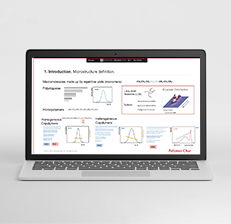
Webinar: Modern Separation Techniques for Polyolefin Microstructure Characterization
Webinar Modern Separation Techniques
Date: November 2021
Speaker: Alejandro Fernández
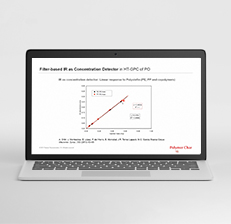
Webinar: Recent developments in the characterization of Polyolefins. An overview of modern separation techniques.
Webinar ABPol
Date: March 2021
Speaker: Alberto Ortín

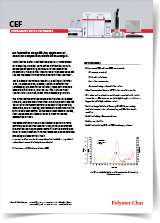
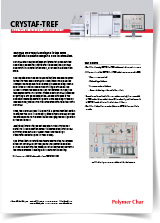
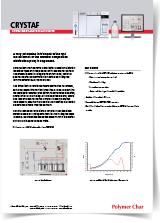
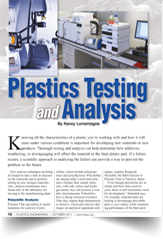
Article: Plastics Testing and Analysis
Published in Plastics Engineering. Society of Plastics Engineers (SPE)
October 2011. Pages 10-16
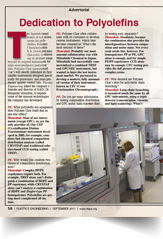
Article: Dedication to Polyolefins
Published in Plastics Engineering. Society of Plastics Engineering (SPE)
September 2011
Pages 58-59
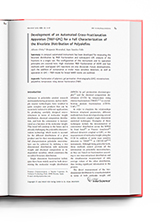
Quantification of PP contamination in recycled PE by TREF analysis for improved the quality and circularity of plastics
Published in Polymer Testing
Volume 100, 107273
August 2021
Author: Rafael Juan , Beatriz Paredes , Rafael A. García-Muñoz , Carlos Domínguez
LATEP, Polymer Technology Laboratory
Rey Juan Carlos University
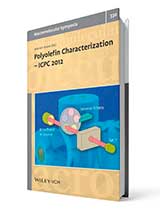
Advances in Thermal Gradient Interaction Chromatography and Crystallization Techniques for Composition Analysis in Polyolefins
Published in: Macromolecular Symposia. Polyolefin Characterization, ICPC 2012.
Volume 330, 2013, Pages 9-21, Wiley-VCH.
Authors: Benjamin Monrabal, Esther López, Loli Romero

Poly(propylene) Heterophasic Copolymers: Molecular Structure Analysis through Fractionation Techniques
Published in: Macromolecular Symposia. Polyolefin Characterization, ICPC 2012.
Volume 330, 2013, Pages 30-41.. Wiley-VCH.
Authors: S. Liberman, A. P. de Azeredo, F. P. Dos Santos, M. A. da Silva, B. Monrabal, N. Mayo

Characterization of Polypropylene–Polyethylene blends by Temperature Rising Elution and Crystallization Analysis Fractionation
Published in: Analytical and Bioanalytical Chemistry. Separation Science of Macromolecules.
ISSN 1618-2642, Volume 399, Number 4, 2011, Pages 1557-1561.
Authors: B. Monrabal, P. del Hierro.
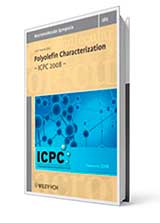
Advances in Crystallization Elution Fractionation
Published in: Macromolecular Symposia. Polyolefin Characterization, ICPC 2008.
Volume 282, 2009, Pages 14-24. Wiley-VCH.
Authors: B. Monrabal, L. Romero, N. Mayo, J. Sancho-Tello.

Phase Structure and Crystallization Behavior of Polypropylene in-Reactor Alloys: Insights from Both Inter- and Intramolecular Compositional Heterogeneity
Published in: Macromolecules, 2007
Volume 41, Issue 3, Pages 826-833
Authors: H. Zhu, B. Monrabal, C. C. Han, D. Wang
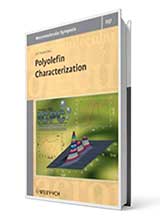
Synthesis and Characterization of Ethylene/Propylene Copolymers in the Whole Composition Range
Published in: Macromolecular Symposia. Polyolefin Characterization, ICPC 2006.
Volume 257, 2007, Pages 122-130. Wiley-VCH.
Authors: M. J. Caballero, I. Suarez, B. Coto, R. V. Grieken, B. Monrabal.

Development of an Automated Cross-Fractionation Apparatus (TREF-GPC) for a Full Characterization of the Bivariate Distribution of Polyolefins
Published in: Macromolecular Symposia. Polyolefin Characterization, ICPC 2006.
Volume 257, 2007, Pages 13-28. Wiley-VCH.
Authors: A. Ortín, B. Monrabal, J. Sancho-Tello.

Microstructure Characterization of Polyolefins. TREF and CRYSTAF. Progress in Olefin Polymerization Catalysts and Polyolefin Materials
Published in: Asian Polyolefin Workshop. Studies in Surface Science and Catalysis.
Volume 161, 2006, Pages 35-42.
Author: B. Monrabal

用结晶分级仪快速表征聚烯烃树脂 的分子链结构
Rapid Characterization of Polyolefins and their Blends using CRYSTAF.
Published in: Petrochemical Technology, China. 2004.
Authors: Wei Dong, Luo Hangyu, Xin Xuhong, Sheng Jianfang, Huang Honghong, Guo Meifang.

Effect of molecular weight and average comonomer content on the Crystallization Analysis Fractionation (CRYSTAF) of ethylene α-olefin copolymers
Published in: Polymer, 2003
Volume 44, Issue 8, Pages 2391-2401
Authors: S. Anantawaraskul, J. B. P. Soares, P. M. Wood-Adams, B. Monrabal.

Performance of Crystallization Analysis Fractionation and Preparative Fractionation on the Characterization of γ-Irradiated Low-Density Polyethylene
Published in: Journal of Applied Polymer Science.
Volume 94, Issue 4, 2004, Pages 1803-1814.
Authors: F. Vilaplana, V. Morera-Escrich, P. del Hierro, B. Monrabal, A. Ribes-Greus

Crystallizability of Ethylene Homopolymers by Crystallization Analysis Fractionation
Published in: Journal of Polymer Science.
Part B: Polymer Physics. Volume 39, Issue 14, 2001, Pages 1616-1628.
Authors: J. Nieto, T. Oswald, F. Blanco, J. B. P. Soares, B. Monrabal.

Analysis of Polyolefin blends by Crystallization Analysis Fractionation
Macromolecular Materials and Engineering.
Volume 279, 2000, Pages 46-51.
H. Pasch, R. Brüll, U. Wahner, B. Monrabal.

TREF and CRYSTAF technologies for Polymer Characterization
Published in: Encyclopedia of Analytical Chemistry
2000 Issue, Pages 8074 – 8094
Author: B. Monrabal

Characterization of homogeneous ethylene/1-octene copolymers made with a single-site catalyst. CRYSTAF analysis and calibration
Published in: Journal of Polymer Science.
Part A: Polymer Chemistry, Volume 37, Issue 1, 1999, Pages 89-93.
Authors: B. Monrabal, J. Blanco, J. Nieto, J. B.P. Soares.

Polyolefin analysis by single-step Crystallization Fractionation
Published in: Journal of Polymer Science, 1999
Volume 37, Issue 6, Pages 539-552
Authors: L. J. D. Britto, J. B. P. Soares, A. Penlidis, B. Monrabal.

Crystallization analysis fractionation of poly(ethylene-co-1-octene) made with single-site-type catalysts: a mathematical model for the dependence of composition distribution on molecular weight
Published in: Macromolecular Chemistry & Physics, 1998
Volume 199, Issue 9, Pages 1917-1926
Authors: J. Soares, B. Monrabal, J. Blanco, J. Nieto

Chemical Composition Distribution in Complex Polyolefin Resins. Characterization of Blends and Dual reactor (single site-Ziegler type) resins by CRYSTAF methods.
Published in: Houston Polyolefins & Elastomers Conference Proc.
1998, Pages 179-188.
Author: B. Monrabal.

Chemical Composition Distribution Analysis in Polyolefins: Introduction to Crystallization Analysis Fractionation
Published in: New Trends in Polyolefin Science and Technology
1996, Pages 119-133.
Author: B. Monrabal

CRYSTAF: A new approach to the Composition Analysis of Semicrystalline polymers
Published in: Macromolecular Symposia.
Volume 110, 1996, Pages 81-86.
Author: B. Monrabal.

Crystallization Analysis Fractionation: A new technique for the analysis of branching distribution in polyolefins
Published in: Journal of Applied Polymer Science, 1994
Volume 52, Issue 4, Pages 491-499
Authors: Benjamin Monrabal
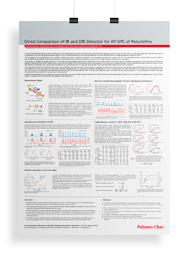
Poster: Advances in Dynamic Crystallization technique for the characterization of the Chemical Composition Distribution
Poster
Presented at the 8th ICPC
2023

Poster: Assessing the co-crystallization on blends of ethylene 1-octene copolymers by CRYSTAF
Poster
Presented at the 7th ICPC
2018

Poster: Automated analysis of the soluble fraction in PP resins by a modified TREF technique
Poster
Presented at the 5th ICPC
2014
Document Request
To receive a copy by email please check the boxes above and complete the following form. Thank you for your interest.